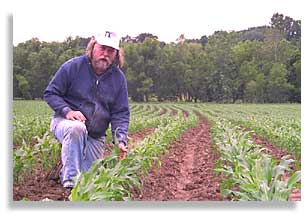|
We must change federal farms and food policy Roger Allison Columbia, Missouri
Once again we’re facing an economic crisis in agriculture. This is a direct result of failed Federal Farm policies that removed the safety net for family farmers, didn’t address a supply management program or ensure fair and open markets for producers. The results of these policies have allowed a handful of corporations unfair control of entire sectors of agriculture.
Since 1994 real consumer food prices have increased by 2.8% while family farmer prices have fallen by 35.7% and major food corporations’ profits have soared. There are some potential solutions for independent producers, however there are also some quote "easy answers" that we need to take a closer look at. Livestock production contracts are touted as a way producers can eliminate market risks. The history of these contracts have been good for corporations while they are essentially non-negotiable for farmers -- take it or leave it. Producers get the debt, environmental liability and no way out. Contract farmers typically borrow at least $150,000 (to as much as $750,000) for initial confinement buildings and equipment. While that mortgage hangs over their families’ heads, they will, if everything works out perfectly, take home about $8.00 an hour after paying corporate-determined expenses. There is some potential for producers in fixed-price marketing contracts -- unfortunately the majority of current marketing contracts are formula-priced. This has typically not been beneficial to the producers and has allowed the possibilities of packers to manipulate prices. One of the problems producers face is that they then become part of the captive supply. These prices are currently not required to be publicly reported -- so it is difficult to tell what your fair economic position is. There is a movement to make USDA enforce the packers and stockyards act to the fullest extent possible which could prohibit packers from owning or feeding livestock and would force USDA to issue rules determining under what circumstances marketing agreements and formula-pricing are violations of the Packers and Stockyards Act. Our position is that formula-pricing should be greatly restricted and that fixed-price contracts should be traded on the open market. This would enhance the economic position of producers with fixed-price contracts as well a those producers selling on the open market. Value-added opportunities for producers are there. With consumer price increases and decreased producer prices there is a tremendous amount of room for value-added endeavors -- particularly within the livestock industry. For example, in the hog industry consumer prices have gone up by 30% in the last 12 years while the farmers share of the retail dollar has dropped from 46% to 22% (down to 12%) December 1998. Somebody has been making a profit in the hog industry and there is no reason why it shouldn’t be the producers. Value-added activities in the livestock sector do have a unique set of challenges such as; processing cost, refrigeration and freezer storage, transportation and the overall barrier of breaking into a corporate dominated market. But it can be done, and there are successful models. The key is to separate your product from the rest and to capitalize on all marketable attributes of your product. Patchwork Family Farms is one example of a successful model of value-adding livestock. This is a producer project that produces processes and markets a full line of sustainably produced pork products. The project’s standards include:
Patchwork products are marketed through restaurants, supermarkets and directly to consumers. The goals of Patchwork are to:
Success:
One potentially helpful state legislative action is HB888 which will provide for value-added projects in the form of tax credits and grant moneys. We will be working to ensure that those resources are not exclusively targeted to closed coops, but can be utilized by a variety of creative producer initiatives. Summary There are no easy answers -- we must change federal farms and food policy to ensure that we have a safe, abundant and affordable food supply and that family farmers have access to fair and open markets -- but in the interim there are value-added possibilities for producers. |
||||||||||||
|
Published in In Motion Magazine May 3, 1999. Also read:
|
||||||||||||
If you have any thoughts on this or would like to contribute to an ongoing discussion in the  What is New? || Affirmative Action || Art Changes || Autonomy: Chiapas - California || Community Images || Education Rights || E-mail, Opinions and Discussion || En español || Essays from Ireland || Global Eyes || Healthcare || Human Rights/Civil Rights || Piri Thomas || Photo of the Week || QA: Interviews || Region || Rural America || Search || Donate || To be notified of new articles || Survey || In Motion Magazine's Store || In Motion Magazine Staff || In Unity Book of Photos || Links Around The World NPC Productions Copyright © 1995-2020 NPC Productions as a compilation. All Rights Reserved. |
||||||||||||


